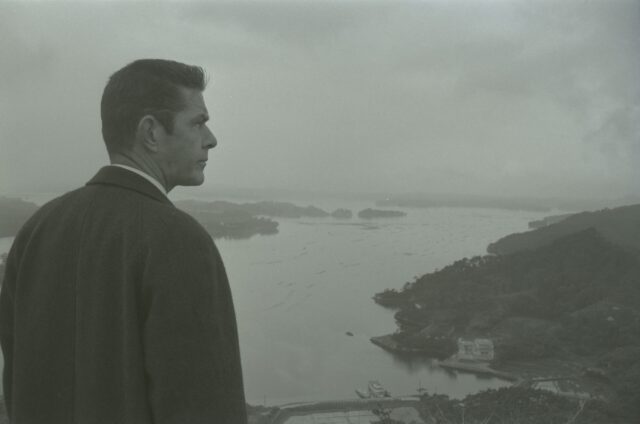
John Cage’s unique relationship with Japan and Japanese culture will be celebrated in Japan Society series (photo by Yasuhiro Yoshioka / courtesy of Sogetsu Foundation)
JOHN CAGE’S JAPAN
Japan Society
333 East 47th St. at First Ave.
Thursday, September 28, and Friday, September 29, $28-$35, 7:30
Saturday, October 21, Thursday, November 16, Thursday, December 7, $32-$40
212-715-1258
www.japansociety.org
“If John Cage had not encountered Japanese culture, there would have been no John Cage!” Japan Society artistic director Yoko Shioya recently declared.
In 1989, experimental composer John Cage was awarded the Kyoto Prize in the category of Creative Arts and Moral Sciences; the citation, presented in Kyoto, Japan, noted that he was “a rebel against Western music. . . . His creative activities and philosophy of art have truly constituted a revolution in culture. . . . Mr. John Cage has stood in the vanguard of change in the postwar Western musical world, and has continually demonstrated his leadership among the most avant-garde group of composers.” Cage, who was born in Los Angeles in 1912, first visited Japan in 1962; he returned in 1964, 1976, and several times in the 1980s. Not only was Cage impacted by Japanese art and culture — he was particularly interested in Zen Buddhism — but he was a major influence on such Japanese composers as Tōru Takemitsu, Toshiro Mayuzumi, Yoko Ono, and Yuji Takahashi, in what was called “Jon Kēji shokku,” or John Cage Shock.
Japan Society pays tribute to the relationship between Cage and Japan in the series “John Cage’s Japan,” which kicks off September 28-29 with Paul Lazar’s Cage Shuffle. From 1958 to 1960, Cage wrote and recorded a series of sixty-second real-life anecdotes called Indeterminacy. At Japan Society, Lazar, the cofounder of Big Dance Theater, will perform pieces related to Japan and the East; using an iPhone — “a device that John Cage invented,” Lazar jokes in the above video — Lazar will have Cage’s recordings of the stories piped into his earbuds and will repeat them out loud, along with quotes from such Cage contemporaries as D. T. Suzuki, Isamu Noguchi, and Hidekazu Yoshida. Meanwhile, Lazar will be moving to choreography by BDT cofounder and Tony winner Annie-B Parson. The movement is fixed but the text is random, creating the kind of chance Cage was celebrated for. The September 29 show will be followed by an artist Q&A.
On October 21, “John Cage’s Ryoanji” features the composer’s 1983 work, inspired by the Zen rock garden at Kyoto’s Ryoanji Temple. Directed by Tomomi Adachi, it will be performed by International Contemporary Ensemble in New York City (with Michael Lormand on trombone, Lizzie Burns on double bass, and Clara Warnaar on percussion), joined virtually from a teahouse in Kanazawa City by Hitomi Nakamura on the ancient hichiriki woodwind and Maki Ota on vocals. The multimedia concert, with 3D projections by Dr. Tsutomu Fujinami, will be preceded by a lecture from Cage scholar James Pritchett at 7:30.
Adachi’s “Noh-opera / Noh-tation: Decoding John Cage’s Unrealized Project” takes place on November 16 at 7:30, for which Adachi used AI to compose music and lyrics based on Buddhist koans for Cage’s unrealized Noh-opera: Or the Complete Musical Works of Marcel Duchamp. The work will be performed by vocalist Gelsey Bell, noh actor Wakako Matsuda, and Adachi with ICE’s Alice Teyssier on flute, James Austin Smith on oboe, Campbell MacDonald on clarinet, Rebekah Heller on bassoon, and Lormand on trombone and will be followed by an artist Q&A.
The series concludes on December 7 with “Cage Shock: Homage to His First Japan Visit,” consisting of a lecture by Dr. Pritchett, live performances of 1951’s Haiku, 1958’s Aria and Solo for Piano with Fontana Mix, and 1962’s 0’00” by Cage, Toshi Ichiyanagi’s 1962 Sapporo, which Cage conducted, and soundscapes by Tania Caroline Chen and Victoria Shen, with ICE’s Kyle Armburst on viola, Wendy Richman on viola, and Katinka Kleijn and Michael Nicolason on cello.
“I must express my deep and sincere gratitude to John Cage,” Takemitsu wrote. “The reason for this is that in my own life, in my own development, for a long period I struggled to avoid being ‘Japanese,’ to avoid ‘Japanese’ qualities. It was largely through my contact with John Cage that I came to recognize the value of my own tradition.” At Japan Society this fall, we can all express our deep and sincere gratitude to John Cage.